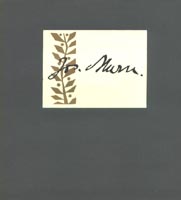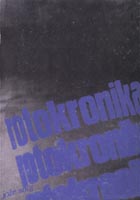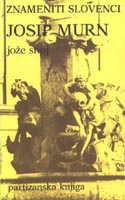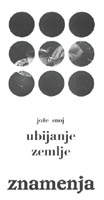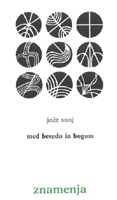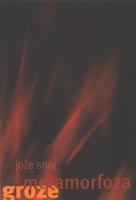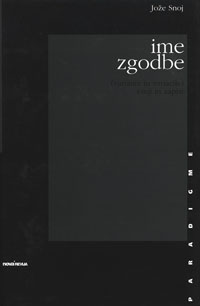


(Click on the picture to enlarge it)
|
|
Josip Murn Selection of poems of Slovene poet Josip Murn with the introduction of Jože Snoj. |
|
|
In the Lines and Between Them This is a selection of critiques of national
and foreign belletristic literature. Here the author explains his modernistic
criteria about style and ideas in literature and his critical philosophical
criteria about Christian existentialism. He is explaining all that "in
the lines" and (to hide them from the censorship of the regime)
"between the lines", too. |
|
|
|
|
Printing Chronicle Also a selection of leading articles in the
years 1970-72 for a weekly magazine "Tedenska tribuna" in the same
"interline" style. |
|
|
Josip Murn This is a literary-historical study, which deals with the poetic growth of Josip Murn who was misunderstood until now and who is an unacknowledged originator of modern Slovene poetry. The Slovene poet who lived at the beginning of the 20th century died very young but was "father" of Slovene poetical modernism ("Slovene Rimbaud"); he was the "inventor" of paradox, sound symbols, distanced lyrical objectivisation, and free verse as prosodically liberated verse line. |
|
|
|
|
The Killing of Soil This examination of the extensive prose opus
of a traditionalist realistic "partisan writer" Karel Grabeljsek
proves, that under his surface apology for revolution hides a tragically
divided registration (written by an honest writer) of its criminal
excessiveness. The Killing of Soil is a metaphor for the irreconcilability of
the peasant's primary (proprietorial, individual) link with nature and of the
construct of "proletarian unproprietorial" collectivization. The
soil only - and not the factory - unmasks its inhumanity and life
non-viability. |
|
|
Handke's Paradox It is not the intention of this study to
adopt the German writer Peter Handke in whatever way
"nationalistically", but to remind us of a certainly unique
phenomenon in world literature. The
hero of Handke's novel "Die Wiederholung"/ "Repetition"-
in the metaphorical meaning - is his forgotten Slovene language; but the
reaching by calling it from the depths of his child's memory is written in
German! This "paradox", caused by Handke’s being deeply moved by
Slovene language into which he was born, opens to the secret of language as
the house of being; tracing this circulating "bilingualism" it
opens even beyond - in the house of the language of languages, which is the
Spirit. |
|
|
|
|
In Between Word and God In these essays the author starts to develop his "theological poetics" or "poetical theology", the basis of which is the relationship between God and the word in the sense of theological presumption that God and man re-establish each other as well as in the poetical sense that the bearer of their interacting "re-establishments" is WORD. The word is the call and the outcry of the self-conscious, cosmically lonely man for the sense of existence. More specifically, God "would not exist", if there were no Godlike creature to think and feel it. And vice versa: man as a thinking being "would not exist", if he was not awakened (according to John's gospel) from unconsciousness (of blind and deaf world) by the creative Word/Logos/Christ as the triad God's son and at the same time the incarnate Son of M”an. Each word in all languages (the house of the language of languages is SPIRIT) is - as the ontologically inexpressible naming of objects and phenomena of the world - in itself the "tiniest" poem. As such "poem unit", the word is the creator of the sparingwords lyrics, denselywords epics and word concentrated dramatics; it is the generator of emotion (as the outcry and the call to the Unknown), of description (as the description of man's existential situation) and of confrontation (as morally ethical conflicting between man's materially instinct and his spiritual nature). The word, which is more artistic the more there is in it the original ontological power, is the link between man and God - there are poets between word and God. |
|
Metamorphosis of Horror The collection of these essays is again the
author's reflection of the bolshevist revolution in Slovenia during the
Second World War, its causes as well as its consequences after the war and
finally in the time of independent state. The title comes from the fragments
of the poem “Metamorphosis of Horror”, written in the years 1957/59 (it was
not possible in that time to publish it), which deals with the theme of the
slaughter of the "home-guards" at the territory of Rog southeast
from Ljubljana in June 1945, when the war was already over. This military
formation, "home-guards" or “white guards”, was nationalistic and
in its basis politically oriented towards the
|
|
|
|
The Name of the Story This book is a collection of the author's latest essays. In the essay »Name of the Story« the author is researching the roots of the mythology and comes to the conclusion, that there is nothing in a myth which surpasses the rationality of human perceptions; but nevertheless, there is still something shrouded in mystery in the mythical images. The man's »story«, starting with his selfconsciousness, is a story of a person, that has a name, but no one knows, what it is. |
|
Back |
